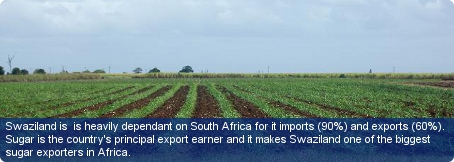Find a business in Swaziland

The small, landlocked kingdom of Swaziland grew well in the 1990s – 3.4% per annum (1990-2000) – but has seen economic growth stagnate in the 2000s. Swaziland has a GNI per capita of US$2,860 (2012) and GDP growth has been 0.8% per annum (2008-12). Apart from the exception of a small border with Mozambique, the country is almost entirely surrounded by South Africa, upon which it is heavily dependent for its imports (90%) and exports (60%). In the long term the country has one of the best growth records in Africa, but a heavy dependence on soft drink concentrate, sugar cane and on South Africa, makes the economy vulnerable.
The manufacturing sector has diversified since the mid-1980s. Sugar, timber and wood pulp remain important foreign exchange earners. The sector contributes 37% of Swaziland’s GDP. The most important products of the growing manufacturing sector include soft-drink concentrates, confectionery and canned fruit; clothing and textiles; and wood pulp, furniture, timber and paper/board products.
Agriculture, forestry and fisheries contribute 8% of Swaziland’s GDP (2010). Agriculture on about 60% of the land is small-scale; the main crop is maize and the most important livestock is cattle. Most of the rest of the country comprises of large estates – extensive areas of which are irrigated – engaged mainly in the production of sugar cane, citrus fruit, pineapples, cotton and cattle, or in forestry. Subsistence agriculture occupies more than 80% of the population.
The country is vulnerable to both floods and drought and has one of the highest HIV/AIDS infection rates in the world; around 26% of adults (aged 15-49) are infected with HIV. The country is faced by other problems such as overgrazing, soil depletion, drought, and some fundamental constitutional issues surrounding the future role of the monarchy in Swaziland. The country also relies heavily on revenue from the Southern African Customs Union, and worker remittances from South Africa substantially supplement domestically earned income.
There are 3,590 km of roads and at least 30% of them are paved. A 300-km railway traverses the country, giving rail as well as road access to Swaziland’s nearest ports – Maputo in Mozambique and Durban in South Africa. As of 2010 the new international airport, at Sikhuphe to the east of Manzini, was almost finished.
Swaziland is ranked 124th for ease of doing business, but 47th and 48th for dealing with construction permits and getting credit respectively, according to the World Bank’s ‘Doing Business 2012’ study, a ranking of 183 countries. It is also placed 13th out of 46 countries in Sub-Saharan Africa for ease of doing business. These rankings measure the conduciveness of a regulatory regime in starting and operating a business.
Literacy among people aged 15-24 is 98%, while for adults it is 91.2% (2010). English is generally used in professional and business life. The majority of people live in rural areas, and farming is the chief occupation. About a quarter of the labour force is employed in manufacturing and the rest primarily works in the public sector. The services sector accounts for 47% of GDP (2010) but most of this is government services.



